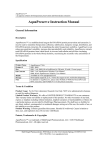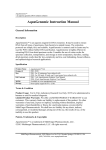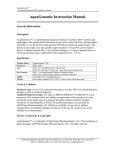Download AquaPlasmid User Manual - MultiTarget Pharmaceuticals
Transcript
AquaPlasmid - an aqueous plasmid isolation solution AquaPlasmid Instruction Manual General Information Description AquaPlasmid is a multifunctional reagent for plasmid DNA purification. This single solution completes cell suspension, cell lysis, plasmid DNA extraction and cell debris removal in a single tube. AquaPlasmid is nontoxic. It does not contain hazardous chemicals, such as guanidine hydrochloride, used in column-based methods. The multifunctionality makes AquaPlasmid the most economic and environment-friendly plasmid purification product on the market. The isolated plasmid DNA is pure and suitable for all downstream applications, including automated DNA sequencing. Specification Product Name Product # Size Kit Contents MSDS Storage AquaPlasmid Kit 1001, 1015, 1030, 1060 0.2 ml AquaPlasmid solution for 1.5 ml culture (miniprep) 2 ml AquaPlasmid solution for 15 ml culture (midiprep) 20 ml AquaPlasmid for 150 ml culture (maxiprep) 1001: 1 ml AquaPlasmid solution, User Manual 1015: 15 ml AquaPlasmid solution, User Manual 1030: 30 ml AquaPlasmid solution, User Manual 1060: 60 ml AquaPlasmid solution, User Manual Available at www.aquaplasmid.com Store tightly capped at 22°C. Terms & Conditions Product Usage: For In Vitro Laboratory Research Use Only. NOT to be administered to humans or used for medical diagnosis. Limited Product Warranty: We offer a LIMITED PRODUCT WARRANTY to our customers. This warranty limits our liability to replacement of this product. No other warranties of any kind, express or implied, including without limitation, implied warranties of merchantability or fitness for a particular purpose, are provided by MultiTarget Pharmaceuticals. We shall have no liability for any direct, indirect, consequential, or incidental damages arising out of the use, the results of use, or the inability to use this product. Patents, Trademarks & Copyrights AquaPlasmid is a trademark of MultiTarget Pharmaceuticals, LLC. 2015 Multitarget Pharmaceuticals, LLC. All rights reserved. MultiTarget Pharmaceuticals, 5050 Edison Ave Ste 214, Colorado Springs, CO 80915, USA (801) 769-6586, www.aquaplasmid.com AquaPlasmid - an aqueous plasmid isolation solution AquaPlasmid Miniprep Protocol (1.5 ml LB or TB culture yields 5-10 µg and 10-20 µg of plasmid DNA respectively) 1. Harvest the Cells Transfer 1.5 ml of overnight bacterial culture to a 1.7-ml microfuge tube. Centrifuge at 14,000 xg for 1 min at 22 °C to pellet the bacteria. Aspirate or flip the tube forcefully a few times to remove the culture medium as completely as possible. 2. Lyse the Cells Add 200 µl of AquaPlasmid solution to the cell pellet. Immediately touch-vortex (a few seconds on and a few seconds off) at top speed for 10-20 sec to fully suspend the cells. Incubate at 22 °C for 10 min to lyse the cells. 3. Remove the Debris Incubate the crude lysate at -20 °C for 5 min or on ice for 10 min to induce precipitation. Centrifuge at 14,000 xg for 5-10 min at 22 °C to pellet the cellular debris. IMPORTANT: Do not invert or vortex or shake the crude lysate after the lysis incubation or it will cause genomic DNA contamination! 4. Pellet the Plasmid DNA Transfer the clear lysate (~180 µl, be careful not to transfer any cellular debris) to a clean 0.5-ml microfuge tube. Add 0.5 vol (~90 µl) of isopropanol to the lysate (do not use more than 0.7 vol of isopropanol for DNA precipitation to avoid contamination). Touchvortex at top-speed 5-10 times to mix well. Centrifuge at 14,000 xg for 5 min at 22 °C to pellet the plasmid DNA. Flip the tube (you may hold 6-10 tubes between your thumb and index finger at the same time) forcefully a few times to discard the supernatant. 5. Rinse the Plasmid DNA To rinse the DNA pellet (nearly invisible; a large DNA pellet indicates that the cell density exceeds the capacity of AquaPlasmid), overflow the tube with 70% ethanol from a squirt bottle (be sure to rinse the inside of the lid as well), and then flip the tube with a swirling motion to discard the ethanol solution. Flip the tube forcefully a few times and blot it on a paper towel to remove residual ethanol. Leave the tube upside down on the paper towel for 5 min to air-dry the DNA pellet. Add 50 µl of deionized water (or TE buffer) to the DNA pellet. Vortex for 30 sec and incubate at 22 °C for 5 min to fully solubilize the DNA. Centrifuge at 14,000 xg for 2-3 min to pellet any insoluble (nearly invisible). Optional: transfer the DNA solution to a new tube. MultiTarget Pharmaceuticals, 5050 Edison Ave Ste 214, Colorado Springs, CO 80915, USA (801) 769-6586, www.aquaplasmid.com AquaPlasmid - an aqueous plasmid isolation solution AquaPlasmid Midiprep Protocol (15 ml LB or TB culture yields 50-100 µg and 100-200 µg of plasmid DNA respectively) 1. Harvest the Cells Transfer 2x 1.9 ml overnight bacterial culture to two 2-ml microfuge tubes and centrifuge at 14,000 xg for 1 min at 22 °C. Aspirate or flip the tube forcefully a few times to remove the culture medium as completely as possible. Repeat pelleting the bacteria from 1.9 ml culture in the same tube for 4 times for a total 7.5 ml culture per tube. 2. Lyse the Cells Add 1 ml of AquaPlasmid solution to each tube. Immediately vortex at top speed for 2030 sec to fully suspend the cells. Incubate at 22 °C for 10 min to lyse the cells. 3. Remove the Debris Incubate the crude lysate at -20 °C for 5 min or on ice for 10 min to induce precipitation. Centrifuge at 14,000 xg for 10 min at 22 °C to pellet the cellular debris. IMPORTANT: Do not invert or vortex or shake the crude lysate after the lysis incubation or it will cause genomic DNA contamination! 4. Pellet the Plasmid DNA Transfer the clear lysate to two 1.7-ml microfuge tubes (~0.8 ml each; be careful not to transfer any cellular debris; if necessary centrifuge the clear lysate again to remove any carried-over debris). Add 0.5 vol (~0.4 ml) of isopropanol to each tube (do not use more than 0.7 vol of isopropanol for DNA precipitation to avoid contamination). Touch-vortex at top-speed 5-10 times to mix well. Centrifuge at 14,000 xg at 22 °C for 5 min to pellet the plasmid DNA. Flip the tube forcefully a few times to discard the supernatant. 5. Rinse the Plasmid DNA To rinse the DNA pellet (it is a nearly invisible thin film on the sidewall; a large DNA pellet indicates that the cell density exceeds the capacity of AquaPlasmid), overflow the tube with 70% ethanol from a squirt bottle (be sure to rinse the inside of the lid as well), and then flip the tube with a swirling motion to discard the ethanol solution. Repeat the ethanol rinse once. Flip the tube a few times and blot it on a paper towel to remove residual ethanol. Leave the tube upside down on the paper towel for 5 min to air-dry the DNA pellet. Add 200 µl of deionized water (or TE buffer) to each DNA pellet. Vortex for 30 sec and incubate at 22 °C for 5 min to fully solubilize the DNA. Centrifuge at 14,000 xg for 2-3 min to pellet any insoluble. Transfer the DNA solution to a new tube. MultiTarget Pharmaceuticals, 5050 Edison Ave Ste 214, Colorado Springs, CO 80915, USA (801) 769-6586, www.aquaplasmid.com AquaPlasmid - an aqueous plasmid isolation solution AquaPlasmid Maxiprep Protocol (150 ml LB or TB culture yields 0.5-1 mg and 1-2 mg of plasmid DNA respectively) 1. Harvest the Cells Centrifuge 150 ml of overnight bacterial culture at 14,000 xg for 2 min at 22 °C to pellet the bacteria. Aspirate or decant to remove the culture medium partially and leave behind ~20 ml of medium. Vortex to resuspend the cells and transfer the cell suspension to a 50ml high-speed centrifuge tube. Centrifuge again to pellet the cells. Aspirate or decant to remove the medium as completely as possible. 2. Lyse the Cells Add 20 ml of AquaPlasmid solution to the cell pellet. Immediately vortex for 20-30 sec to fully suspend the cells. Incubate at room temperature for 15 min to lyse the cells. 3. Remove the Debris Incubate the crude lysate at -20 °C for 5 min or on ice for 15 min to induce precipitation. Centrifuge at 14,000 xg for 15 min at 22 °C to pellet the cellular debris. IMPORTANT: Do not invert or vortex or shake the crude lysate after the lysis incubation or it will cause genomic DNA contamination! 4. Pellet the Plasmid DNA Transfer the clear lysate (~18 ml) to a new 50-ml centrifuge tube. Centrifuge the clear lysate for 5 min to remove any carried-over debris. Pour the clear lysate to a new 50-ml centrifuge tube. Add 0.5 vol (~9 ml) of isopropanol to the clear lysate (do not use more than 0.7 vol of isopropanol for DNA precipitation to avoid contamination). Touch-vortex at top-speed 5-10 times to mix well. Centrifuge at 14,000 xg at 22 °C for 10 min to pellet the plasmid DNA. Flip the tube forcefully a few times to discard the supernatant. 5. Rinse the Plasmid DNA Gently shoot 20-25 ml of 70% ethanol into the tube from a squirt bottle. Roll the tube to rinse the entire interior of the tube, and then decant the tube to discard the ethanol solution. Repeat the ethanol rinse once. Flip the tube forcefully a few times and blot it on a paper towel to remove residual ethanol. Leave the tube upside down on the paper towel for 5-10 min to air-dry the DNA pellet. Add 1 ml of deionized water (or TE buffer) to the DNA pellet. Pipet and vortex to suspend the DNA pellet. Incubate at 22 °C for 10 min to fully solubilize the DNA. Centrifuge at 14,000 xg for 5 min to pellet any insoluble and transfer the DNA solution to a new microfuge tube. MultiTarget Pharmaceuticals, 5050 Edison Ave Ste 214, Colorado Springs, CO 80915, USA (801) 769-6586, www.aquaplasmid.com AquaPlasmid - an aqueous plasmid isolation solution Frequently Asked Questions Please read through these questions before using AquaPlasmid kit. The answers provide additional tips and information for the successful use of AquaPlasmid. 1. Do I need to store the AquaPlasmid kit at 4 °C? No, AquaPlasmid solution should be stored at room temperature (~22 °C). If the temperature is below 18 °C, such as during transit or storage in the winter, precipitation may develop. If so, incubate the solution at 37-55 °C for a few minutes to re-solubilize it before use. 2. How does AquaPlasmid work? AquaPlasmid combines the functions of traditional P1 buffer (cell suspension), P2 buffer (cell lysis), N3 buffer (debris removal), and silica column (plasmid DNA purification) in a single solution. It lyses the cells without denaturing the DNA, extracts the plasmid DNA while keeps other cellular contaminants in the cell debris. The plasmid DNA is subsequently precipitated from the clear lysate with isopropanol. 3. Does AquaPlasmid contain guanidine salts? No, AquaPlasmid does not contain guanidine salts. They are required for column-based purification and not biodegradable. When they are mixed with Bleach on the floors, in the sinks or sewage, toxic and mutagenic fumes may be released into the environment, which could be harmful to the workers and aquatic lives. 4. How should I scale up and down the reagent for other culture volumes? We recommend 200 µl of AquaPlasmid for each 1.5 ml of overnight bacterial culture. However, if the cell density is too high, it may result in poor cell lysis, incomplete debris removal and decreased DNA yield. An indication of cell density exceeding the capacity of AquaPlasmid is a large DNA pellet following isopropanol precipitation. In that case, you should use 300 µl of AquaPlasmid for each 1.5 ml of bacterial culture or use 200 µl of AquaPlasmid for each 1 ml of culture. 5. Any specific recommendation on the use of the AquaPlasmid method? We recommend that you use the AquaPlasmid method only on E. coli strains that carry the endA1 mutation, such as TOP10, DH5a, XL-1 Blue, JM109, and SURE, etc. If the genotype is unknown, you should incubate an aliquot of the purified DNA in a restriction enzyme buffer at 37 °C for 12 hours to confirm there is no DNA degradation by gel electrophoresis. If the DNA is degraded, you may try incubating the purified DNA at 7585 °C for 20-30 min to inactivate the contaminating nucleases. MultiTarget Pharmaceuticals, 5050 Edison Ave Ste 214, Colorado Springs, CO 80915, USA (801) 769-6586, www.aquaplasmid.com









